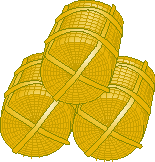Chapter 3: Outperforming the Homemade Taste
Efforts to process sesame by grinding were also a series of successes and failures. Earthenware mortars and hand mills gave the sesame a dry taste, because grinding roughly with these tools caused each grain to become sharply cut. Hand mills are a tool for grinding grain into powder and earthenware mortars are suitable for making sesame paste, but neither seemed suitable for coarse grinding, which requires that bits of grain remain for the sake of texture and a more mellow taste.
The son had the idea of trying a wooden mortar and pestle, a method used in Japan for centuries for making rice cakes. The son retrieved a mortar and pestle from a storeroom at home and tried it immediately. After pounding the sesame for a while by hand, he produced moist sesame with a sweet taste. He had his neighbors taste the crushed sesame, and it was well received as having a richer taste than the ground sesame made at home. The only step that remained was to mechanize the process.
In 1971, the "pestle pounding machine" was built. It was a simple machine comprised of an engine-driven pestle moving up and down above a stone mortar. However, as a machine for processing sesame, it was probably the first in the world, let alone Japan. The method was also new, as it improved on the previous method of grinding sesame to include this additional pounding process. In the years since, the number of pestles used was adjusted, the shape of the tip improved and the weight adjusted in pursuit of the perfect sesame end-product. The history of bringing out the taste and fragrance of sesame products is an accumulation of testing and improvement that spanned numerous variables, including the size and depth of the mortar as well as its material.
This automation of sesame processing began around the start of the second baby boom in Japan, and in this way the history of Onizaki became the contemporary history of sesame. We now have a solid reputation for being the original manufacturers of sesame products that outperform the taste of homemade sesame and come in ready-to-eat small packages.
Pestle Pounding 
The wooden mortar and pestle were tools which were used for milling cereal grains such as rice. This process involves gradually grinding off the bran from the surface of brown rice. The wooden mortar and pestle were essential daily tools in every household.
|

